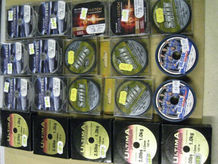Line

Whether you are preparing to fish in a lake, river, or canal, considering the unique personalities of your line will have you on the fast track to
success and making the big catch of the day.
Below are the main components of fishing line:
Below are the main components of fishing line:
Diameter: This determines the line's test strength which features improved line durability. Premium lines offer thinner diameters for increased strength and stability, while also providing you with a more sensitive line to help you feel the fish nibbling on your bait or lure.
Abrasion resistance: When fishing lines are subjected to harsh conditions such as rocks, tree stumps and extreme weather conditions, they need to be abrasion-resistant.
Color: When looking for the perfect line color, consider finding one that is visible to you, while being nearly invisible to a fish. Below are the different color types:
Abrasion resistance: When fishing lines are subjected to harsh conditions such as rocks, tree stumps and extreme weather conditions, they need to be abrasion-resistant.
Color: When looking for the perfect line color, consider finding one that is visible to you, while being nearly invisible to a fish. Below are the different color types:
- Low-visibility: A stealth-like line that blends into most underwater environments when the fish aren't biting or heavy fishing in the area has made the fish smarter.
- Low-visibility clear: This color works well in ultra-clear water or when you know the fishing area you have selected tends to have fish that seem reluctant to bite.
- Clear/blue fluorescent: A perfect balance for sunlight to illuminate the line above the surface, while staying clear below the surface.
- High-visibility gold: This bright color makes it easier to see when a fish strikes and to view your line position in a current. This color is also beneficial for low-light conditions including dawn, dusk, and at night.
- Moss green: This color works well in waters with heavy vegetation or algae.
Pound-Test for Fishing Lines
Fishing line is classified by the "pound-test," the measurement relating to the amount of force, in pounds, required to break the line. The pound-test of the line you use is determined more by the amount of drag pressure you apply than it is by the size of the fish you might catch. In some cases, line can stretch and provide additional durability that exceeds the pound test listed. Below are a few examples:
- Monofilament/Copolymer: Look for line with the lowest diameter-to-pound test ratio for the best performance. Monofilament will break down when exposed to direct sunlight and should be changed every six months to a year depending on how often it is used.
- Braided: Braided lines are stronger per diameter than monofilament; you can often get 60 pounds of breaking strength in braided line that has the same diameter as 30-pound test monofilament.
- Novice anglers: Should choose the line that meets the size of the fish they want to catch. Choose a heavier line if you are unsure.
- Advanced anglers: Should choose to use the lightest line possible to increase the challenge of landing a fish.
Breaking Diameters and Strains of Fishing Line
|
Line diameter 0.06mm 0.07mm 0.08mm 0.09mm 0.10mm 0.11mm 0.12mm 0.14mm 0.16mm 0.18mm 0.20mm 0.22mm 0.24mm 0.26mm |
Average breaking strain 12oz 1lb 2oz 1lb 12oz 2lb 2lb 6oz 2lb 14oz 3lb 4oz 4lb 12oz 5lb 10oz 6lb 8oz 7lb 12oz 9lb 10lb 4oz 11lb 6oz |

